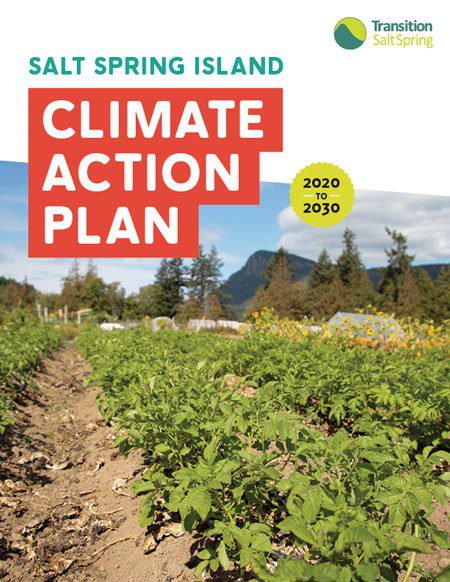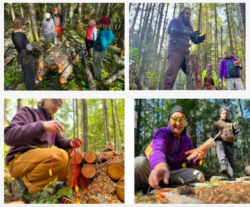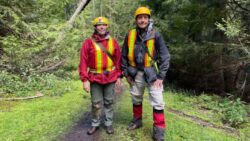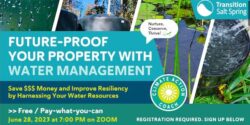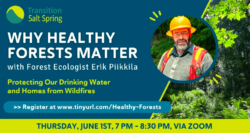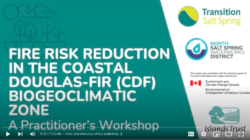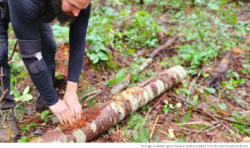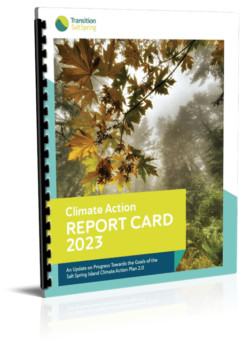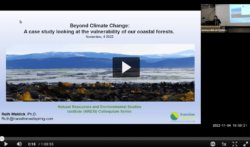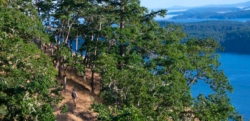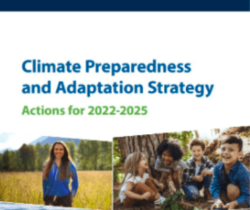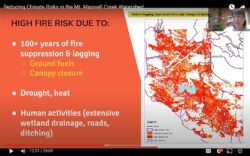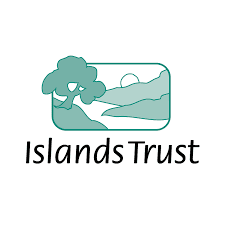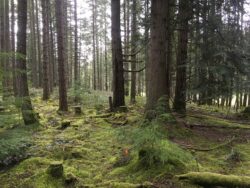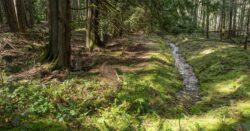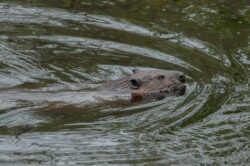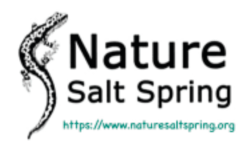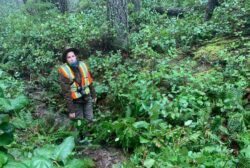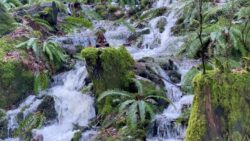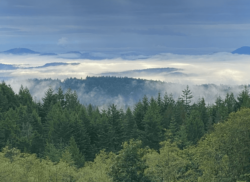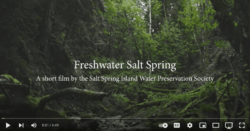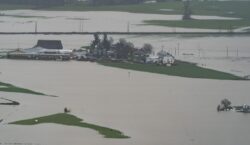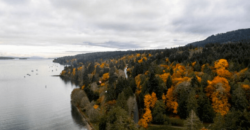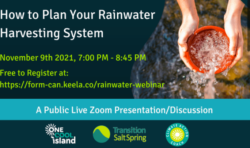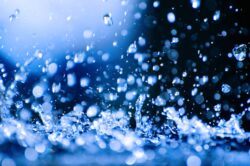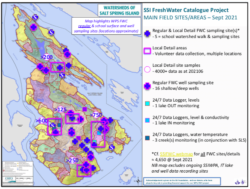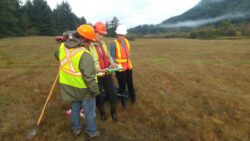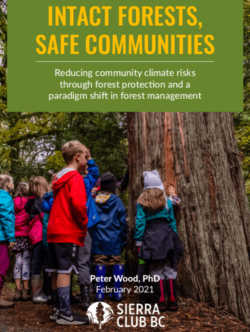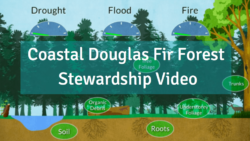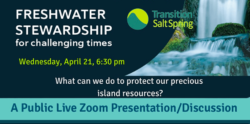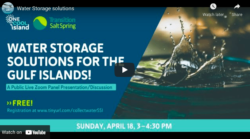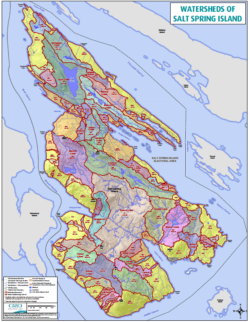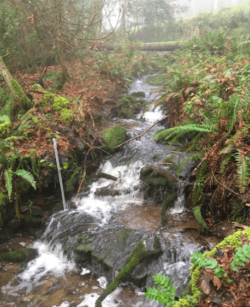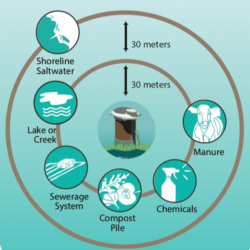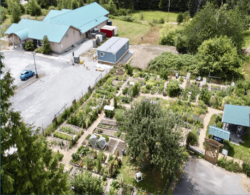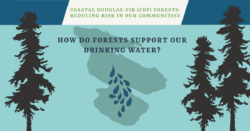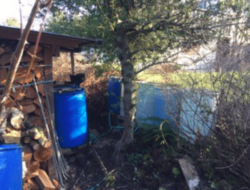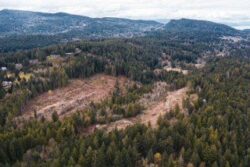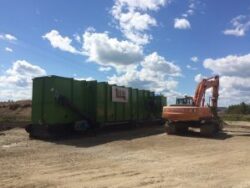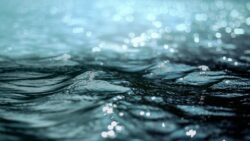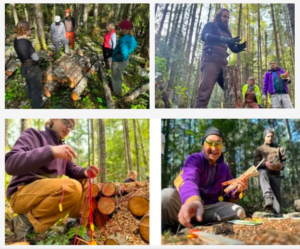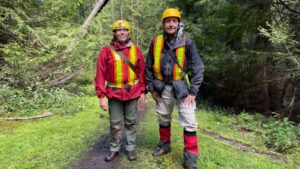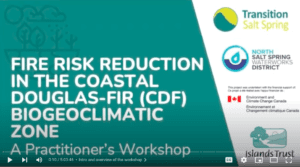Water is Life
Salt Spring already has freshwater challenges that impact potable water supplies, farms and gardens, and water-sensitive ecosystems. In spring 2020, the island was under conservation drought measures, and burning had been banned. Warmer and drier summers, and more intense winter precipitation, will exacerbate the situation in the coming decades.
Lakes and streams supply over half the drinking water on Salt Spring Island, while groundwater and rainwater storage provide the remainder. Annual water recharge comes entirely from winter rain. Decreased rainfall, higher temperatures, forest fires, and increased run-off during torrential rains will increase water demand and decrease supply. Increased turbidity from increased storm activity and forest fires interferes with water disinfection and treatment, while excess nutrients can cause algal blooms, leading to taste and odour issues and potential risks to human health.
These increased stresses on freshwater supplies make the need for water conservation more urgent than ever. Salt Spring Islanders must get better at capturing and storing winter rainfall while improving the efficiency of summer outdoor water use. This will be especially important in coastal areas supplied by wells because overdrawing groundwater can lead to saltwater intrusion.
Many creeks and wetlands play a role in storm-water management. During extreme weather events or peak run-off, creeks can flood and soils become saturated, increasing run-off and flooding low-lying areas. Clearing trees reduces water infiltration into soils and aquifers, allowing more water runoff to the sea.
Extreme summer water shortages affect drinking water quality, ecosystem health, the quality and costs of community water supply, and water-dependent industries such as tourism and food processing. Human health can be impacted by a rise in water-borne and vector-borne diseases. In addition, people with natural-resource-based livelihoods can face unemployment and lost businesses, resulting in economic and psychological distress. Recovery from such extreme seasonal water shortages can take months and cost the economy and government millions of dollars.
The future viability and safety of our island’s potable water supply will be under increasing threat if we do not act now to protect it in the face of increasing drought, higher temperatures, and more damaging storms. Forests and freshwater ecosystems are two key interlocking pieces that can help build community resilience in the face of multiple climate-change-related threats.
News, Events and Resources
Climate Adaptation Research Lab – Restoring the Maxwell Watershed with North Salt Spring Waterworks District.
TSS’s CARL project among finalists announced for 2023 Nature Inspiration Awards
Healthy forests can help protect us from disasters
Future-proof your Home with Water Management: $ave Money and Improve Resiliency by Harnessing Your Water Resources – Video
Why Healthy Forests Matter in Reducing Fire and Drought Risk with Erik Piikkila – Video
Fire Risk Reduction in the Coastal Douglas-fir Biogeoclimatic Zone- Video
Reducing Fire and Drought Risk with Erik Piikkila
Maxwell Creek Watershed Field Files
Climate Action Report Card
Beyond Climate Change – A Case study looking at our Vulnerable Forests
Maxwell Creek Watershed Project Field Files Part 2: Developing surveying methodologies
BC Releases Climate Preparedness and Adaptation Strategy
Reducing Climate Risks in the Mt Maxwell Creek Watershed
Ruth Waldick Wins the Islands Trust 2022 Community Stewardship Awards!
Notes from the Field: Updates from the Mt. Maxwell Team
Maxwell Creek Watershed Project Field Files Part 1: Project Impetus
Learning from Nature: Nature-based Approaches to Restoration in the Maxwell Creek Watershed
June Nature Extravaganza
Maxwell Creek Watershed Project
World Water Day – March 22nd, 2022
Non-profit in Salt Spring Island, B.C. offers rebate to homeowners collecting rainwater
Maxwell Watershed Project Radio Interview
Freshwater on an island: Salt Spring, British Columbia, Canada- Video
We can’t ignore the role deforestation plays in triggering devastating floods
Freshwater availability: Options for maintaining a healthy water supply into the future
How to Plan Your Rainwater Harvesting System- Video
Transition helps islanders tap into winter rains
THE SSI FRESHWATER CATALOGUE
Freshwater is Life: Reconciling and Restoring Island Wetlands
INTACT FORESTS, SAFE COMMUNITIES
Freshwater Stewardship for Challenging Times – Video
Water Storage Options Presentation Resources- Video
SSI Watershed map
ERN seeking volunteers to help with a SSI Watershed Stewardship Video Series
Freshwater resources
Water Conservation – Small Island Solutions
On Salt Spring, Every Drop Is Precious
Rainwater collection tour
Urgent Appeal to Protect Salt Spring Old Growth Trees and Wetlands from Destruction. 40 acres of Larmour Legacy Lands
Waste Management & Carbon Sequestration
Water Conservation – Time to Brush Up!
What Salt Spring Can Do
- Practice ecosystem-based planning on a watershed level.
- Protect and restore lakes, ponds, wetlands, watercourses, and aquifers to ensure that our ecosystems have sufficient moisture to lower fire and storm risks.
- Increase riparian buffers along water bodies.
- Implement wide-scale rainwater harvesting, enhanced water conservation, and climate change risk management practices that protect our water resources, such as forest retention.
- Prevent forest fires to protect water quantity and quality.
- Protect and restore lakes, ponds, wetlands, watercourses, and aquifers to ensure that our ecosystems have sufficient moisture to lower fire and storm risks.
Resources, News & Events
Climate Adaptation Research Lab – Restoring the Maxwell Watershed with North Salt Spring Waterworks District.
TSS’s CARL project among finalists announced for 2023 Nature Inspiration Awards
Healthy forests can help protect us from disasters
Future-proof your Home with Water Management: $ave Money and Improve Resiliency by Harnessing Your Water Resources – Video
Why Healthy Forests Matter in Reducing Fire and Drought Risk with Erik Piikkila – Video
Fire Risk Reduction in the Coastal Douglas-fir Biogeoclimatic Zone- Video
Success Stories
Freshwater issues are widely recognized on Salt Spring, and a number of measures have already been taken to research, educate, inform, and act. The following is a brief sample:
- Salt Spring Islands Watershed Protection Alliance (SSIWPA) coordinates rainwater harvesting education and interagency collaboration for cooperative management of water resources.
- The Official Community Plan identifies drinking water watersheds, well capture zones, and high erosion areas; its policies and regulations restrict development in these areas.
- Salt Spring Island Local Trust Committee up-zones (such as allowing higher density in an application) conditional on rainwater catchment and storage in some areas.
- North Salt Spring Water District (NSSWD) completed a new water treatment plant (St. Mary DAF plant) in 2019 and plans a new treatment plant for Maxwell Lake.
- NSSWD placed a moratorium on new water connections in 2014 and has conservation regulations in place.

